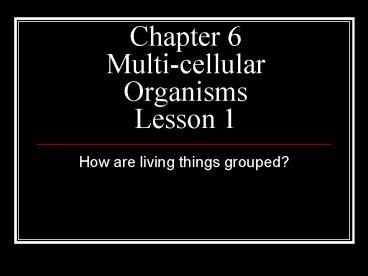Chapter 6 Multi-cellular Organisms Lesson 1 - PowerPoint PPT Presentation
1 / 15
Title:
Chapter 6 Multi-cellular Organisms Lesson 1
Description:
Chapter 6 Multi-cellular Organisms Lesson 1 How are living things grouped? Vocabulary Preview Classification: process of grouping similar things together Kingdom: a ... – PowerPoint PPT presentation
Number of Views:101
Avg rating:3.0/5.0
Title: Chapter 6 Multi-cellular Organisms Lesson 1
1
Chapter 6Multi-cellular OrganismsLesson 1
- How are living things grouped?
2
Vocabulary Preview
- Classification process of grouping similar
things together - Kingdom a major, large group of similar
organisms - Species a single kind of organism that can
reproduce among its own kind
3
Classification
- When you walk into your kitchen at home, you
probably know where to find most things. - The forks are in a certain drawer with spoons and
knives. - Soups, vegetables, macaroni are all in a pantry
- Can you think of other items in your kitchen that
have a certain place? - Putting similar items together in a kitchen makes
cooking and cleaning up easier.
4
Classification
- The process of classification, or grouping
similar things together, makes sense in a
kitchen. - It also helps scientists who study living things.
- No one can know everything about the 10 MILLION
different kinds of organisms that live on Earth. - By identifying characteristics that living things
share, scientists can group similar organisms
together. - Scientists look for similarities in the way
organisms look, live, eat, move, grow, change and
reproduce
5
CLASSIFICATION
- What characteristics do these two animals share?
6
Grouping Living Things
- Scientists classify for many reasons.
- How can classifying make things easier?
- It makes finding/sharing information easier
- When they discover a new organism they can look
at other organisms they have already studied
7
The Five Kingdoms https//www.brocktonpublicschoo
ls.com/uploaded/TeachingLearning/ScienceResourcesK
-8/OtherResources/Grade_6_Science_PowerPoint_on_5_
Kingdoms.ppt
One classification system divides all organisms
into five kingdoms Animals, Plants, Fungi,
Protists, and Bacteria. What characteristics does
each kingdom have?
8
Grouping Living Things.
- Scientists classify living organisms into major,
large groups called kingdoms. - All members of each kingdom have certain
characteristics - Different methods of classification have
different members of kingdoms-either five or six
9
Grouping Living Things..
- Scientists need to classify animals together
because animals are made of many cells and they
feed on other living or once living things. - Plants have many cells also, but they make their
own food. - Fungi are many-celled organisms, but they dont
make their own food. They absorb it from the
remains of other organisms. - Protists are one celled organisms
- Bacteria are all one celled organisms
- Their cells have no nucleus
- Most feed the way fungi do, but some make their
own food.
10
Smaller Groups
- Kingdoms include many different organisms.
- The members of each group share more and more
characteristics. - The smallest group contains only one kind of
organism.
11
(No Transcript)
12
Smaller Groups
- First Step divide each kingdom into smaller
groups. - A Phylum-is a major group within a kingdom
- Organisms in a phylum have more characteristics
in common than do organisms in different phyla. - Phylas are divided into classes, classes are
divided into orders, and orders are divided into
families. - Just as in your family, members of the same
family share many characteristics - Like human families, they have individual
differences. - A genus can contain one or more specied.
- A Species is a unique kind of organism
13
Smaller Groups..
- Every different kind of living thing has its own
specific name. - This name includes the names of the smallest two
groups-genus and species - Example The scientific name for a house cat is
Felis domesticus. Felis is the names of its
genus. - The names of its species is domesticus.
- House cats and only house cats have this name
- When scientists use this name they know they are
only talking about house cats.
14
Smaller Groups.
- To divide larger groups into smaller groups,
scientists look for characterisitics that some
members of one group have but others dont. - Example Butterfly is the only animal in the top
group that doesnt have a backbone. - Soooo the butterfly doesnt belong to the same
phylum as the other animals. - At the next level, all the animals except the
fish are mammals, so the fish doesnt belong - As the group gets smaller, each group includes
organisms that are more alike
15
(No Transcript)































